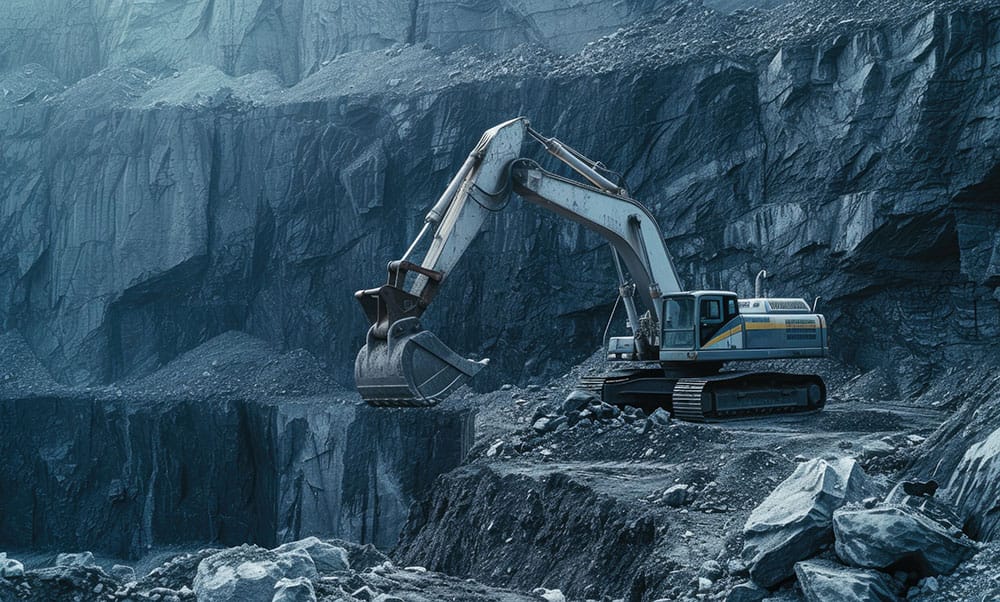Mining and Minerals Industry
The mining and minerals industry is a vital part of the global economy, providing essential raw
materials for a wide range of industries, from construction and manufacturing to technology and
energy. However, the industry itself is complex, operating across diverse geographies, and involving
various stakeholders including governments, investors, suppliers, and consumers.
Main Role of a Website in the Mining and Minerals Industry
Why Mining and Minerals Industry needs Website?
In this highly competitive and regulated industry, effective communication, operational transparency,
and business efficiency are crucial. This is where a well-designed, functional website comes into play.
A website can serve as the face of the company and as a digital tool that helps streamline processes,
engage with stakeholders, and drive business growth.
When developing a website for the mining and minerals industry, it’s essential to integrate specific
functionalities that cater to the unique needs of this sector. These functionalities will not only
enhance the user experience but also improve business operations, data management, and
regulatory compliance. Here’s a detailed exploration of the most critical functionalities needed for
mining and minerals industry websites.
Company Overview and Corporate Information
A robust booking system is critical for converting website visitors into customers. This system should include:
- Company History: A timeline or story of the company’s development, key milestones, and major projects.
- Leadership Profiles: Information on the management team, board of directors, and key personnel.
- Mission and Vision: The company’s objectives, values, and goals in the industry
- Corporate Governance: Policies and documents related to governance, sustainability, and compliance with industry regulations.
This section establishes credibility and allows potential investors, partners, and other stakeholders to
gain insight into the company’s operations and objectives.
Project and Operations Information
Mining and Minerals Industry operate large-scale projects across different geographical locations, each with
unique challenges and goals. A dedicated section on the website that showcases detailed
information about ongoing and past projects can be highly beneficial. This section should include:
- Project Locations: An interactive map showing the geographical locations of all mining operations.
- Project Details: Descriptions of each project, including project phases, resources being extracted, production volumes, and timelines.
- Sustainability Practices: Information on how each project adheres to environmental regulations, minimizes impact on local communities, and ensures sustainable practices.
- Performance Metrics: KPIs related to project efficiency, safety, and economic impact
This level of detail will build transparency and trust with investors, government authorities, and local
communities.

Investor Relations Portal
The mining and minerals industry relies heavily on capital from investors. Therefore, providing a well-organized and accessible investor relations section is crucial. The investor relations portal should include:
- Financial Reports: Quarterly and annual reports, balance sheets, income statements, and other financial documents.
- Press Releases: Announcements regarding mergers, acquisitions, new projects, and other corporate news.
- Stock Information: Real-time stock price information, historical performance charts, and investor tools.
- Investor Presentations: Presentations used at investor meetings, earnings calls, or industry conferences.
- Contact Information for Investor Queries: A direct line for investors to communicate with the company’s investor relations team.
A robust investor relations portal will ensure that shareholders and potential investors are always
informed, leading to increased confidence and potentially more investment opportunities.
Product and Service Listings
For companies engaged in the extraction and distribution of minerals, it is crucial to have a detailed
section dedicated to the products and services offered. This section can include:
- Mineral Listings: A catalog of the minerals or ores extracted, including detailed descriptions, uses, and specifications.
- Processing Capabilities: Information on the company’s ability to refine and process raw materials.
- Value-added Services: Any additional services such as logistical support, packaging, and supply chain management.
- Case Studies and Testimonials: Examples of successful projects or partnerships with other industries, showcasing how the company has provided value.
By presenting this information, a mining company can effectively market its offerings and reach a
broader audience, including manufacturers, distributors, and industry partners.
Sustainability and Corporate Social Responsibility (CSR)
Environmental sustainability and social responsibility are key concerns in the mining and minerals industry due to the potential environmental impact of mining operations. Websites should have a dedicated section focused on:

- Environmental Initiatives: Highlighting efforts to reduce the ecological footprint of mining operations, including recycling, reclamation of mined lands, and energy-efficient practices.
- Community Engagement: Details on how the company is contributing to local communities through jobs, infrastructure development, education, and healthcare initiatives.
- Safety Standards: Documentation of safety measures implemented at mining sites to protect workers and nearby residents.
- Sustainability Reports: Public reports showcasing how the company is adhering to international and local environmental standards and benchmarks.
This section is important for building trust with stakeholders, including government authorities,
environmental advocacy groups, and the general public.
Compliance and Legal Information
Given the highly regulated nature of the mining industry, a section that outlines compliance with
national and international regulations is essential. This can include:
- Licenses and Permits: Information on the company’s compliance with local mining laws, including permits and licenses for operation.
- Health, Safety, and Environment (HSE): Policies and practices to ensure the safety of employees and minimize environmental harm.
- Legal Disclosures: Details of any ongoing litigation or regulatory issues, ensuring transparency with stakeholders.
- Regulatory Reports: Regular reports submitted to government agencies regarding safety, environmental, and economic performance.
By providing this information, mining companies demonstrate their commitment to operating within the legal framework and adhering to best practices.

Contact Information and Interactive Tools
A comprehensive contact section is critical, allowing stakeholders to engage with the company easily.
This includes:
- General Inquiries: Contact forms for general queries.
- Investor Relations: Direct contact information for investors
- Suppliers and Vendors: A portal for potential suppliers and vendors to reach out regarding procurement opportunities.
- Recruitment: Job listings and an application portal for prospective employees.
Interactive tools can further enhance the functionality of the contact section, such as:
- Live Chat: A chatbot or live chat feature to assist users in real time
- Geo-location Tools: Allowing users to pinpoint the nearest regional office or project location for in-person inquiries.


News and Events Section
The mining industry is dynamic, with constant changes due to new projects, market conditions,
regulatory changes, and technological innovations. A regularly updated news and events section will
keep the audience informed about the latest developments. Key content includes:
- Press Releases: Announcements of major developments, contracts, or achievements
- Industry News: Curated news articles related to the mining and minerals sector
- Events and Conferences: A calendar of upcoming industry conferences, webinars, or company-hosted events.
- Media Gallery: A collection of images, videos, and multimedia showcasing mining operations, company events, and community initiatives.
This section keeps the website dynamic and regularly updated, drawing more frequent visits and
engagement.
Investor and Customer Support Portal
In addition to having a contact section, companies can offer an investor or customer support portal.
For investors, this could include features such as:

- Downloadable Documents: Access to important reports, documents, and data sheets.
- Support Forums: A discussion forum where investors or partners can engage with the company and each other.
- FAQ Section: A detailed FAQ covering common questions related to operations, projects, and corporate performance.
For customers, the portal can include:
- Order Tracking: For customers purchasing or shipping minerals, an order tracking feature provides transparency in the supply chain.
- Account Management: Customers can view invoices, manage account details, and handle transactions securely.
Multilingual and Accessibility Features
Given the global nature of the mining industry, mining websites should cater to a diverse audience by
offering multilingual capabilities. Additionally, compliance with accessibility standards is essential to
ensure inclusivity. This can include:
- Language Options: Offering website content in multiple languages for different regions and stakeholders.
- Accessibility Standards: Ensuring that the website adheres to the Web Content Accessibility Guidelines (WCAG) to provide a user-friendly experience for people with disabilities.


Integration with Enterprise Resource Planning (ERP) Systems
Mining companies often rely on ERP systems to manage complex operations, including logistics,
human resources, finance, and supply chain management. Integrating the company’s website with
ERP systems allows for seamless updates on inventory, financial performance, and operational
metrics.
A well-designed and functional website is crucial for the mining and minerals industry, as it serves
not only as the digital face of the company but also as an essential tool for communication,
operations, and business development. Incorporating the functionalities outlined above can enhance
transparency, efficiency, and stakeholder engagement, leading to long-term success in this
competitive and regulated industry.

